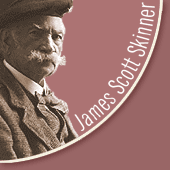




The Dances on Video
We have based most of the dances in these videos on James Scott Skinner’s
booklet, published in 1905: The People’s Ball Room Guide (JSS0900-JSS0949).
It has not always been easy to interpret the instructions as Skinner has left
much unsaid. Those reading the Guide in the 1900s would have been familiar
with the dance movements.
The Ballroom Dances
The ballroom dances Skinner describes only arrived in this country during the 19th century. Many of these, such as Quadrilles and Quadrille Lancers were extremely popular. Skinner’s ballroom dances include couple, or circle dances, such as:
and dances for four couples, where the dancers are arranged in a square formation:
Other ballroom dances performed on the video are:
- The Grand March (vc18)
- The Eightsome Reel (vc32)
- The Waltz (vc03)
- The Polka (vc04)
- La Varsoviana (La Va) (vc05)
- The Highland Schottische (vc34)
- The German Schottische (vc01)
- The Barn Dance (vc02)
The Country Dances
In country dances, couples line up facing each other, men on one side and ladies on the other. Usually the couple at the top dance first, then move to the bottom of the set and the new top couple begins.
In common with many of the dances Skinner described, the country dances demonstrated
in the videos are still danced today, but have changed through time.
For example, the ‘pousette’ Skinner used, where a couple join both
hands and dance down to the bottom of the set, is no longer common. Nowadays,
couples use the pousette to circle round each other, often changing places.
In Skinner’s day, dances were generally danced at a faster tempo. It
is likely that couples did not stand still, but danced on the spot when it
wasn’t their turn.
We perform the following country dances:
- Triumph (vc07)
- Petronella (vc14)
- Flowers of Edinburgh (vc08)
- La Tempete (vc19)
- Rory o’ More (vc09)
- Waltz Country Dance (vc15)
- The Merry Lads o’ Ayr (vc06)
- Circassian Circle (vc20)
- Haymakers (vc17)
The Highland Dances
The Strathspey and Half Reel of Tulloch
We have used Donald Richard Mackenzie’s: Illustrated Guide to the National Dances of Scotland (JSS0357-JSS0403) for:
Mackenzie is an excellent source. His book was intended for teachers rather than for learners, so he even provides metronome marks, which made setting dance speeds much easier. His description of the Sword Dance, however, was not easy to interpret.
For the Strathspey and Reel, we decided to use some of Mackenzie’s ladies’ ballroom steps, rather than men’s competition steps.
The Seann Triubhas
The steps used in the Seann Triubhas (vc12) have come from David Anderson’s Guide . David Anderson was a dancing master in Dundee in the late 19th and early 20th centuries. This Guide is not in our collection and has not been digitised. If you listen to Skinner playing Whistle o’er the Lave o’t (cd211a) – the tune the Seann Triubhas is danced to, you can hear that the first step is much more accented than the smooth, elegant phrasing we hear today. When performed at the faster speed with hard shoes, the first step, not developed until the 1890s, is much less elegant, and suits the accented music perfectly!
Changes in the Highland Fling
Nineteenth and early twentieth century Highland Dancers used hard-soled shoes – soft shoes were not commonly used until after the First World War (around 1920). We found that the change of footwear combined with faster speeds, altered the dances significantly. They are exciting to watch and to perform:
- The Highland Fling (vc10), becomes just that – the foot ‘flings’ rather than slides round the leg
- The Rocking Step uses the side of the foot rather than the toe. This is closer to percussive step dancing
- We have also allowed the dancer to move: Skinner, in My Life and Adventures said that it was not until the 1890s that a dancing master suggested that dancers should dance on the spot.
This version of the Highland Fling appears in the People’s Ballroom Guide (JSS0927) and comes from steps that Sandy Skinner taught his brother James. Sandy was a dancing master by 1850, so his version of the Highland Fling may date back further than that.
Cèilidh Dancing (to bring us up to date!)
This is quite a recent phenomenon. Many of the dances that Skinner taught as ballroom dances, which were still quite new when he taught them, now fall into this category. Cèilidh dancing is informal, often fast, and the emphasis is on enjoyment, so where people put their feet is not too important!
To illustrate some of the changes in the past hundred years:
- The Highland Schottische (vc34) that Skinner taught (dating from the 1850s), when put together with the German Schottische (vc01), makes the Highland Schottische so popular at cèilidh dances today. The Schottische has moved from the ‘polite’ ballroom to the more ‘informal’ cèilidh dance floor
- The Barn Dance (vc02), which developed into the Canadian Barn Dance, has also gone in the same direction
- The Eightsome Reel (vc32), originally devised for the society ballroom in the 1870s, is now one of the most popular of cèilidh dances.
Pat Ballantyne


Historic
Collections · Kings College · Old
Aberdeen · AB24 3SW
Tel:(0)44 1224 274312 · E-mail: scottskinner@abdn.ac.uk